
Equine Veterinary Medical Manipulation
(aka Chiropractic type adjustments for Horses only by veterinarians)
Frequently Asked Questions About
Equine Veterinary Medical Manipulation
1. What is Equine Veterinary Medical Manipulation (EVMM)?
Medical manipulation is a therapy that uses motion
palpation to find joint restrictions and then uses a
high velocity, low amplitude (HVLA) thrust directed
in the plane of the joint to help restore normal range
of motion to the joint. An HVLA is based on proper
knowledge of equine anatomy and joint
biomechanics and does notrequire massive strength
to apply. Because the manipulation takes place
near the end of the horsesnatural range of motion for
that selected joint, the thrust is very low in
amplitude. Medical manipulation restores freedom of movement, relaxes the muscles and relieves the pain of a restricted joint. EVMM is medical manipulation practiced by licenced veterinarians and is focused exclusively on equines.
2. Is medical manipulation and chiropractic the same thing?
No. Chiropractic, as defined by law, applies specifically and only to humans. A chiropractor is someone who has completed human chiropractic training and has a Doctor of Chiropractic degree (DC). When similar techniques are applied to animals, it is correctly called spinal manipulation or medical manipulation.
3. How does EVMM differ from massage and Tui-Na?
EVMM uses an HVLA thrust to directly affect the joint and the mechanorecepters around the joint. Tui-na and massage do not use HVLA thrust, and affects the muscle. However, all three of these modalities work very well together and the combination can be beneficial for many patients.
Dr. Harvey is trained in Tui-na and has a reputable list of equine massage therapists if needed. Many times, Dr. Harvey can show you message, Tui-Na and physical therapy techniques that you can use on your horse yourself to speed healing and prolong comfort.
4. What makes Dr. Harvey’s EVMM training and certification unique?
Dr. Harvey was trained and certified by the IVMI ( Integrative Veterinary Medical Institute ) www.ivmi.us. Training through the IVMI is the only medical manipulation course that is offered exclusively to veterinarians and focuses strictly on equine medicine. It is this veterinarian only approach that truly sets the IVMI's training apart from many others. This is because, since the class being entirely composed of veterinarians (or 3rd or 4th year vet school students), the course material is able to delve far more in-depth than it otherwise would be able
.to
Additionally, because the focus of IVMI and it’s courses is on integrative medicine, an all-veterinarian class means that there are more opportunities for discussing the conventional and integrative medicine diagnostics, as well as 40 hours of direct, hands-on wet lab experience with diagnostics and treating real cases. If human chiropractors were in the course, diagnostics would not be able to be discussed. But, because of this veterinarian-only setup, the EVMM course is able to focus on the hands-on wet labs and explore veterinary education level radiology, oxygen therapy, ultrasound therapy, dissection of equine cadavers and sport/discipline/breed specific biomechanics.
5. Can acupuncture and EVMM be used on the same day?
Yes! Acupuncture and EVMM are synergistic. Conventional medicine treats damaged tissue directly, EVMM restores range of motion and acupuncture supports both. The greatest benefits to the patient are seen when they are combined into one treatment.
6. When can I ride/school/show my horse after treatment, and how often should I have you see my horse?
It is suggested that the horse has an 8-12 hours of turnout and/or stall rest, after treatment. A pre-show adjustment and treatment is
a great way to get that edge up on your competition!
Ideally all high performing horses should be examined every 4-6weeks. The examination as performed by Dr. Harvey includes gait analysis, cranial nerve exam, acupuncture exam and motion palpation of all joints, axial and appendicular ( limbs ). This 4-6
week schedule allows her to remove restrictions before they cause secondary issues and before adhesions become permanent. She
has many high end performance horses that are evaluated by her monthly but may not need to be treated but a couple times per
year. She finds this to be due to a successful dialogue established between herself and these horses riders. With this schedule she
can also keep you abreast of how your horse/s are responding to your training and showing schedule.
7. "My horse had a nasty accident" or "my horse is really old", would EVMM be good for her?
Potentially yes, and potentially a fatal disaster for your horse! This is where having a licensed equine veterinarian making a manipulation treatment decision is critical. Injuries, joint trauma or severe arthritis symptoms of the equine spine can be subtle to the non-veterinarian but can in fact indicate something quite serious. Dr. Harvey performs a complete neurological exam on every patient and will weigh the risks of proceeding based on her findings and the history. In many of such cases, at the very least, she can perform acupuncture for pain relief and will require further conventional medical diagnostics before she proceeds with any spinal manipulation.
8. Where can I learn more about this service that Dr. Harvey provides?
You can check out Dr. Harvey’s blog on this same website, Wellbeings business facebook page or the IVMI website at www.ivmi.us or e-mail her at vasilikidvm@wellbeingsvet.net

Did you know that each rib has three joints? Lateral bend, flexion, and even breathing can become painful if these joints need adjusting.

Newborn foals and their dams can greatly benefit from being adjusted early and evaluated often!